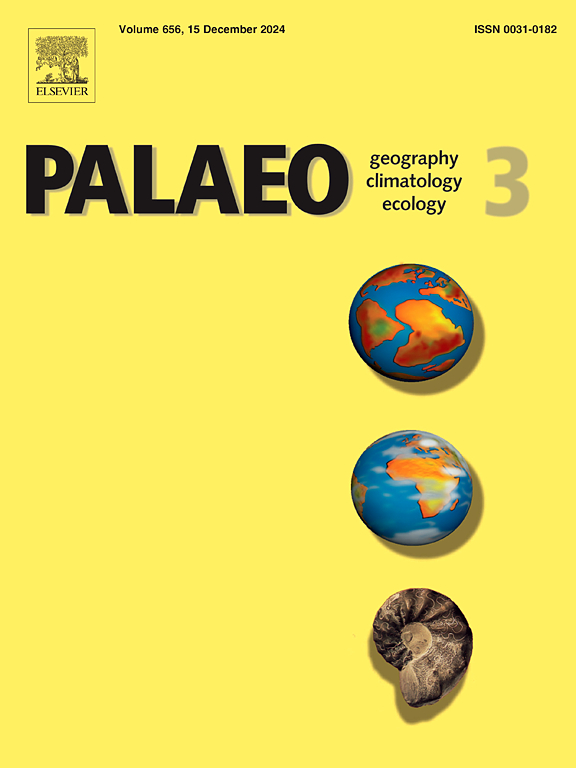Continental red beds in the Ordos Basin (North China Block): Origins and paleoclimatic implications in the aftermath of the Jenkyns Event (Early Jurassic)
IF 2.7
2区 地球科学
Q2 GEOGRAPHY, PHYSICAL
Palaeogeography, Palaeoclimatology, Palaeoecology
Pub Date : 2025-05-30
DOI:10.1016/j.palaeo.2025.113060
引用次数: 0
Abstract
The Jenkyns Event (also known as the Toarcian Oceanic Anoxic Event, ~183 Ma) was one of the most significant hyperthermal events of the Phanerozoic, associated with pronounced environmental and climatic perturbations. The event is characterized in the sedimentary record by a sharp negative carbon isotope excursion and widespread development of anoxic conditions in both terrestrial and marine settings. Following this negative carbon isotope excursion, red beds were deposited over a wide area in the inland Early Jurassic mega-lake systems of China (such as the Sichuan, Ordos, Qaidam, and Tarim basins). Given their widespread distribution, these red beds could hold clues for understanding the pathways by which the Earth system recovered from the Jenkyns Event, yet their origins, geological significance, and their relation to the event are largely unexplored. Here, petrographic, geochemical, mineralogical, and palynological analyses of the red beds have been conducted through the Fuxian Formation of the Anya section, Ordos Basin (North China Block). Paleoenvironmental proxies (Sr/Cu and Rb/Sr) indicate a predominantly semi-arid to semi-humid climate, albeit with oscillations, following the Jenkyns Event. The red beds exhibit characteristics of both primary and diagenetic control and were deposited in an oxidizing environment as indicated by redox indicators (U/Th, Ni/Co, and V/Cr). The sediments may have undergone secondary oxidation or reduction due to frequently fluctuating climatic conditions, resulting in the formation of variegated sediments. The lake was surrounded by a mire vegetation with ferns and lycopsids, but the riparian habitats were characterized by the presence of drier patches and pioneer plant types due to frequent fluctuations in the water level that prohibited the development of more complex lowland forests. Changes in the vegetation after the Jenkyns Event and the significant drop of regionally-sourced pollen types (produced by seed-ferns and conifers), indicate a drop in lake size and catchment area which were likely climatically driven. These climatic fluctuations may have been related to tectonism on the North China Block and the prevailing super-monsoon conditions. We further suggest that the drying climate and increased atmospheric oxygen may have collectively led to the development of red beds in the aftermath of the Jenkyns Event in major terrestrial basins in China.
鄂尔多斯盆地(华北地块)陆相红层:早侏罗世詹金斯事件的成因及其古气候意义
詹金斯事件(也被称为Toarcian Oceanic缺氧事件,约183 Ma)是显生宙最重要的高温事件之一,与明显的环境和气候扰动有关。在沉积记录中,该事件的特征是碳同位素急剧负偏移和缺氧条件在陆地和海洋环境中的广泛发展。在这种负碳同位素偏移之后,中国内陆早侏罗世大型湖泊系统(如四川盆地、鄂尔多斯盆地、柴达木盆地和塔里木盆地)广泛沉积了红色层。考虑到它们的广泛分布,这些红层可能为了解地球系统从詹金斯事件中恢复的途径提供线索,但它们的起源、地质意义以及它们与事件的关系在很大程度上尚未被探索。本文对鄂尔多斯盆地(华北地块)安雅剖面抚仙组红层进行了岩石学、地球化学、矿物学和孢粉学分析。古环境指标(Sr/Cu和Rb/Sr)表明,在詹金斯事件之后,尽管存在振荡,但以半干旱至半湿润为主。氧化还原指标(U/Th、Ni/Co和V/Cr)表明,红色层具有原生控制和成岩控制双重特征,沉积于氧化环境中。由于气候条件的频繁波动,沉积物可能经历了二次氧化或还原,从而形成了杂色沉积物。湖的周围是蕨类植物和石松类植物的沼泽植被,但由于水位的频繁波动,河岸生境的特点是存在干燥斑块和先锋植物类型,这阻碍了更复杂的低地森林的发展。詹金斯事件后植被的变化和区域来源花粉类型(由种子蕨类和针叶树产生)的显著下降表明,湖泊大小和集水区面积的下降可能是气候驱动的。这些气候波动可能与华北地块的构造运动和盛行的超级季风条件有关。我们进一步认为,詹金斯事件后中国主要陆相盆地的红层发育可能是气候干燥和大气氧含量增加共同导致的。
本文章由计算机程序翻译,如有差异,请以英文原文为准。
求助全文
约1分钟内获得全文
求助全文
来源期刊
CiteScore
5.90
自引率
10.00%
发文量
398
审稿时长
3.8 months
期刊介绍:
Palaeogeography, Palaeoclimatology, Palaeoecology is an international medium for the publication of high quality and multidisciplinary, original studies and comprehensive reviews in the field of palaeo-environmental geology. The journal aims at bringing together data with global implications from research in the many different disciplines involved in palaeo-environmental investigations.
By cutting across the boundaries of established sciences, it provides an interdisciplinary forum where issues of general interest can be discussed.

 求助内容:
求助内容: 应助结果提醒方式:
应助结果提醒方式:


